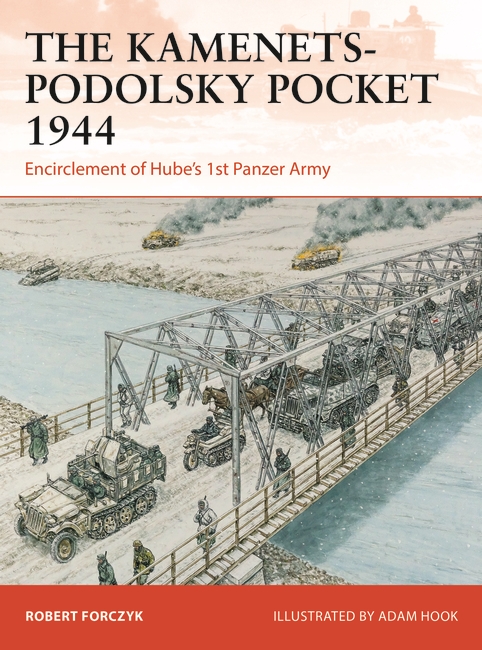
The situation on the Eastern Front in early 1944 was pretty grim for the German Ostheer (Army in the East). The Soviet Red Army was across the Dnepr River in force, had liberated Kiev, isolated one German–Romanian army in the Crimea and had just won a significant victory in the Battle of the Korsun Pocket. While the center of the Axis front was still fairly stable in Belorussia, the German army on the northern end of the front, protecting the Baltic region, was holding on by its fingernails. Even worse, the Soviet Stavka (High Command) was preparing a new round of offensives and the German Oberkommando des Heeres (OKH) had no significant operational reserves available. Marshal Georgy Zhukov, in command of the 1st Ukrainian Front, intended to mount a giant pincer operation in conjunction with Marshal Ivan Konev’s 2nd Ukrainian Front to encircle Generaloberst Hans-Valentin Hube’s 1. Panzerarmee (PzAOK 1) in the Proskurov sector, thereby precipitating a collapse of the entire Axis southern end of the front. Zhukov’s offensive began on 4 March 1944, leading to one of the more dramatic campaigns on the Eastern Front during World War II. The campaign has been popularly dubbed “Hube’s Pocket”.
As a historian, I tend to specialize in operational-level military history, which can be very dry reading for some readers and I regularly hear complaints that my text is laden with constructs such as “unit X moved to Y and attacked Z”. Rinse and repeat. Yes, that’s operational history, which is sorely needed to make sense of complex campaigns. Traditional approaches, by journalists such as Max Hastings, John Keegan or Cornelius Ryan, produce more readable accounts, but such accounts are too broad brush to connect all the dots. In Kamenets-Podolsky 1944, it is essential to have a day-to-day structure that focuses on unit actions in order to make the situation comprehensible. I did in fact have both German and Soviet first-hand accounts from the campaign – which incorporated into the narrative when feasible – but these accounts tend to be riddled with errors. Upon reading survivor accounts, it is clear that most did not know where they were on a particular day and afterwards, blurred together memories from different locations and actions. This is typical in combat memoirs. I also hear complaints about my heavy use of acronyms, particularly German and Soviet ones. My reasons for acronyms are simple: they save space and most soldiers adopt them into force of habit. Spelling out lengthy designations over and over again is disruptive in a narrative.
Other areas of focus for me, as a writer, are armoured operations and technology, intelligence and logistics. Hube’s Pocket saw the convergence of all three focus areas, which makes it particularly interesting. Both sides conducted the campaign under a heavy fog of war, which prevented them from fully seeing the actual battlefield situation, and both operated under severe logistical constraints. On paper, Zhukov should have easily crushed Hube’s out-numbered army, but material factors do not always determine campaigns. Zhukov failed to anticipate enemy actions and consequently, was caught off balance when Hube reacted in an unexpected manner. The Kamenets-Podolsky Pocket represents a near-perfect example of the OODA (Observe-Orient-Decide-Act) Loop in action; Hube quickly reacted to encirclement by Zhukov’s and Konev’s forces, re-oriented toward the west, decided to conduct a breakout operation and then acted decisively to accomplish this goal. Hube was consistently one step ahead of Zhukov, thereby ‘getting inside his OODA Loop’ in modern military parlance. In human terms, the ability of Hube and his subordinates to motivate his exhausted troops to conduct a desperate breakout operation across over 150km of enemy-held terrain, in winter, appears almost superhuman. There is no doubt the battle-hardened troops, led by tough, veteran commanders, were capable of accomplishing extraordinary feats on the battlefield.
The escape of Hube’s 1. Panzerarmee from encirclement had a profound effect on the war. If Hube’s army had not escaped, the Axis Eastern Front would almost certainly have collapsed three months prior to D-Day and the Red Army would likely have penetrated more deeply into Central Europe than actually occurred. Zhukov achieved a significant victory but the escape of Hube’s army limited its impact. Nevertheless, Zhukov learned from his mistakes in the Kamenets-Podolsky campaign and his next round of offensives would prove far more decisive.

Comments
You must be logged in to comment on this post. Click here to log in.
Submit your comment